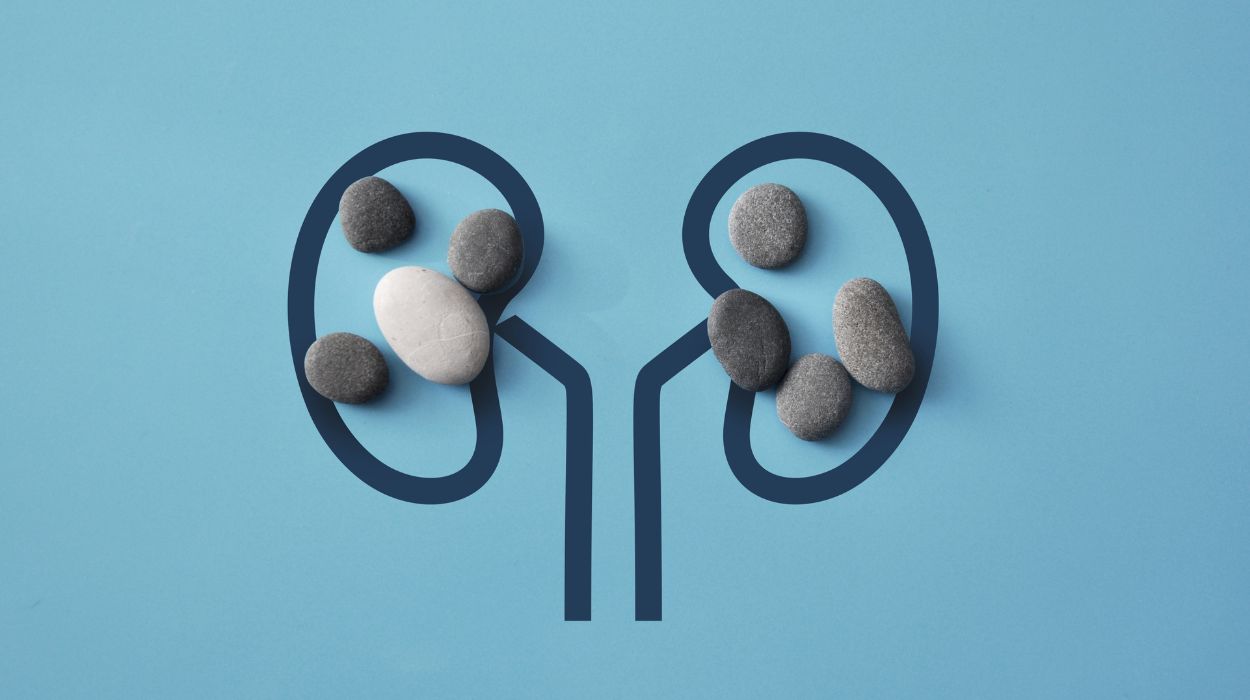 Expert's opinion
Expert's opinion
Expert's opinion
The article is a subjective view on this topic written by writers specializing in medical writing.
It may reflect on a personal journey surrounding struggles with an illness or medical condition, involve product comparisons, diet considerations, or other health-related opinions.
Although the view is entirely that of the writer, it is based on academic experiences and scientific research they have conducted; it is fact-checked by a team of degreed medical experts, and validated by sources attached to the article.
The numbers in parenthesis (1,2,3) will take you to clickable links to related scientific papers.
UTI Vs. Kidney Stones: Differences & Effective Treatment Options In 2024

Ask anyone who’s ever experienced the agonizing pain of a urinary tract infection (UTI)[1] or kidney stone, and you’ll hear tales of extreme discomfort. The sharp, stabbing pain or the constant dull ache can make even the simplest tasks unbearable. But how can you tell if you’re dealing with UTI or kidney stones?
In this article, we dive deep into UTIs and kidney stones, shedding light on their distinctive features, symptoms, and available treatment options. You’ll gain valuable insights into the unique characteristics of UTIs, such as the burning sensation during urination and frequent urges to use the bathroom. We will also explore the signs of kidney stones, such as intense back or abdominal pain and blood in the urine.
But this article is about more than just understanding the differences between the two. We will go the extra mile to provide you with hope and reassurance. Read on to find effective ways to manage UTIs and kidney stones and take proactive steps toward your well-being.
Kidney Stones Vs UTI
Let’s break down the pathophysiology of urinary tract infections and kidney stones. UTIs involve bacterial colonization in the urinary tract, while kidney stones are mineral deposits in the urinary system.
Understanding these unique pathophysiologies will help differentiate the origins, clinical progressions, and physical manifestations of UTIs vs. kidney stones. And with a better understanding comes more effective management strategies for these prevalent urinary problems.
UTI Vs Kidney Stone: Overview

UTI
UTIs are infections that occur in any part of the urinary system, including the bladder, urethra, ureters, and kidneys. The most common cause of UTIs is the entry of bacteria through the urethra into the urinary tract. There are two types of UTIs: lower UTIs, which primarily affect the bladder, and upper UTIs, called pyelonephritis,[2] which involves the kidneys.
Lower UTIs are characterized by symptoms like frequent urination, persistent urge to urinate, burning sensation during urination, and cloudy, smelly urine. Alternatively, upper UTIs present with symptoms like lower back pain, fever, chills, nausea, and vomiting. They mainly indicate a kidney infection.
UTIs are common worldwide, with millions of cases reported annually. Women are more prone to UTIs because they have shorter urethras, which makes it easier for bacteria to enter the urinary tract. Understanding the types of UTIs and associated symptoms is essential to diagnose and manage them correctly.
Kidney Stone
Kidney stones are solid mineral deposits that develop in the kidneys or urinary system. They can vary in size and shape and are composed of substances like calcium, uric acid, or struvite. The most common type of kidney stone is calcium stone[3], formed from calcium oxalate or calcium phosphate. High levels of calcium or oxalate in one’s diet can contribute to their formation.
Uric acid stones are another type of kidney stone. These occur as a result of elevated levels of uric acid in the urine, which can also be seen in conditions like gout and other metabolic disorders. Struvite stones, also known as infection stones, are a type of kidney stone that is primarily composed of magnesium ammonium phosphate. Like other stones that can be influenced by dietary choices or metabolic conditions, struvite stones are directly linked to UTIs.
Kidney stones’ prevalence varies depending on geography, diet, genetics, and lifestyle choices. Identifying the specific type of kidney stone is important as it helps healthcare providers create personalized treatment plans to prevent stone formation and manage the associated symptoms.
UTI Vs. Kidney Stone: Similarities
Kidney stone vs UTI share similarities in their manifestations and symptoms. For example, they both have the potential for stone formation within the urinary system. However, the mode of formation differs. Kidney stones are solid mineral formations, while UTIs can sometimes cause crystals to form.
These conditions can also exhibit similar urinary symptoms[4], which can make determining an accurate diagnosis more challenging. Patients may experience abdominal or lower back pain with both UTIs and kidney stones. In severe cases, UTIs and kidney stones can present with more serious symptoms.
Untreated UTIs can progress to kidney infections, causing high fever, chills, and flank pain. Kidney stones, especially when obstructing the urinary tract, can cause intense pain.
Additionally, UTIs and kidney stones can cause changes in urinary patterns and appearance. Symptoms of a UTI may include increased frequency, urgency, pain or burning during urination, and strong-smelling urine. Kidney stones can lead to cloudy or bloody urine with a strong odor.
UTI Vs. Kidney Stone: Differences

Causes
UTIs primarily occur due to bacterial infections. Escherichia coli (E. coli)[5] is a common culprit that can enter the urinary system through the urethra and multiply, leading to an infection.
Alternatively, kidney stones have various causes[6]. Dehydration plays a significant role as it concentrates the urine and can cause more crystals to form. Dietary choices can also play a role, especially when consuming foods rich in oxalate, such as spinach and chocolate. Furthermore, underlying metabolic conditions, like hypercalciuria or hyperuricosuria, can predispose individuals to kidney stone formation.
Maintaining adequate hydration is crucial to preventing UTIs and kidney stones, and understanding how much you should drink a day can help establish good habits. To reduce the risk of kidney stone formation, avoiding dietary triggers and adopting a healthy lifestyle is advisable.
Diagnosis
UTIs are typically diagnosed through urinalysis[7], a test that examines the urine for bacteria and white blood cells, indicating an infection.
Conversely, to diagnose kidney stones, you may need to undergo imaging tests[8], such as an ultrasound or CT scan, to visualize the stones in the urinary system. These imaging techniques help determine the size, location, and number of stones present. Furthermore, a urinalysis can be performed to analyze the composition of the kidney stones, providing valuable information for optimizing treatment options.
Symptoms
UTI symptoms[9] often include frequent urination, a painful or burning sensation during urination, and an urgent need to urinate. Additional symptoms may include cloudy or strong-smelling urine.
Conversely, the symptoms of kidney stones[10] can vary depending on factors such as their size and location. However, severe kidney stone pain in the back or side is a common symptom. Other kidney stone symptoms may include blood in the urine, pain that radiates to the lower abdomen or groin, and discomfort during urination. Seek prompt medical attention if you experience some of the symptoms listed here.
Treatments
UTIs are typically treated[11] with a course of antibiotics prescribed by a healthcare professional. These medications aim to eliminate the bacterial infection and relieve associated symptoms. It’s important to complete the full course of antibiotics as prescribed to ensure effective treatment. This also reduces the risk of recurrent urinary infections.
Still, antibiotic resistance is a growing concern. Healthcare providers may consider factors such as antibiotic susceptibility when determining the appropriate treatment.
How to get rid of kidney stones depends on various factors, including the size, location, and symptoms associated with the stones. Small kidney stones are more likely to pass naturally without surgery, but doctors often recommend increasing fluid intake and managing pain through medication to facilitate their passage.
Conversely, larger kidney stones may require medical interventions. These can include extracorporeal shockwave lithotripsy (ESWL), which uses sound waves to break the stones into smaller fragments for easier passage. Surgical removal through procedures like ureteroscopy or percutaneous nephrolithotomy is also an option. The choice of treatment depends on the individual case and is determined by healthcare professionals after a comprehensive exam.
While natural remedies like apple cider vinegar for kidney stones are often discussed, their effectiveness has yet to be proven scientifically. It’s important to consult healthcare professionals for evidence-based treatment options. This includes the best probiotic for vaginal health, as mentioned in Uqora reviews.
Complications
Untreated or recurrent UTIs can lead to more severe kidney infections, which may eventually require hospitalization and intravenous antibiotics for effective treatment. These kidney infections, if left untreated, can result in serious complications and compromise kidney function.
Conversely, complications[12] of kidney stones can include urinary obstruction. This will impede urine flow and may contribute to the development of chronic kidney disease. Additionally, recurrent stone formation is possible, increasing the risk of future episodes.
Conclusion
Understanding the differences between kidney stones vs kidney infections is crucial for proper diagnosis and treatment. While both conditions can cause urinary discomfort and share similar symptoms, they have distinct causes and treatment approaches.
UTIs are primarily caused by bacterial infections in the urinary tract, while kidney stones can be caused by various factors, such as dehydration and dietary choices. Proper diagnosis with the aid of urinalysis and imaging tests, is essential to differentiate between the two conditions.
Treatment for UTIs typically involves antibiotics, while kidney stones may require interventions like ESWL or surgical removal. Timely management can prevent complications and ensure optimal urinary health. By being aware of the symptoms, causes, and treatment options, individuals can take proactive steps to maintain their urinary system’s well-being.
+ 12 sources
Health Canal avoids using tertiary references. We have strict sourcing guidelines and rely on peer-reviewed studies, academic researches from medical associations and institutions. To ensure the accuracy of articles in Health Canal, you can read more about the editorial process here
- McLellan, L.K. and Hunstad, D.A. (2016). Urinary Tract Infection: Pathogenesis and Outlook. [online] 22(11), pp.946–957. doi:https://doi.org/10.1016/j.molmed.2016.09.003.
- Mariya Belyayeva and Jeong, J.M. (2022). Acute Pyelonephritis. [online] Nih.gov. Available at: https://www.ncbi.nlm.nih.gov/books/NBK519537/ [Accessed 23 Jun. 2023].
- Worcester, E.M. and Coe, F.L. (2010). Calcium Kidney Stones. [online] 363(10), pp.954–963. doi:https://doi.org/10.1056/nejmcp1001011.
- Ripa, F., Pietropaolo, A., Montanari, E., Theodoros Tokas, Vineet Gauhar and Somani, B.K. (2022). Association of Kidney Stones and Recurrent UTIs: the Chicken and Egg Situation. A Systematic Review of Literature. [online] 23(9), pp.165–174. doi:https://doi.org/10.1007/s11934-022-01103-y.
- Dong Ho Lee, Lee, S.-J. and Choe, H.-S. (2018). Community-Acquired Urinary Tract Infection byEscherichia coliin the Era of Antibiotic Resistance. [online] 2018, pp.1–14. doi:https://doi.org/10.1155/2018/7656752.
- Tilahun Alelign and Petros, B. (2018). Kidney Stone Disease: An Update on Current Concepts. [online] 2018, pp.1–12. doi:https://doi.org/10.1155/2018/3068365.
- Guido Schmiemann, Eberhardt Kniehl, Gebhardt, K., Matejczyk, M.M. and Hummers-Pradier, E. (2010). The Diagnosis of Urinary Tract Infection. [online] doi:https://doi.org/10.3238/arztebl.2010.0361.
- Brisbane, W., Bailey, M. and Sorensen, M. (2016). An overview of kidney stone imaging techniques. [online] 13(11), pp.654–662. doi:https://doi.org/10.1038/nrurol.2016.154.
- Bono, M.J., Leslie, S.W. and Reygaert, W.C. (2022). Urinary Tract Infection. [online] Nih.gov. Available at: https://www.ncbi.nlm.nih.gov/books/NBK470195/.
- Tilahun Alelign and Petros, B. (2018). Kidney Stone Disease: An Update on Current Concepts. [online] 2018, pp.1–12. doi:https://doi.org/10.1155/2018/3068365.
- Nassib Abou Heidar, Degheili, J.A., Yacoubian, A. and Khauli, R.B. (2019). Management of urinary tract infection in women: A practical approach for everyday practice. [online] 11(4), pp.339–339. doi:https://doi.org/10.4103/ua.ua_104_19.
- Leslie, S.W., Sajjad, H. and Murphy, P.B. (2023). Renal Calculi. [online] Nih.gov. Available at: https://www.ncbi.nlm.nih.gov/books/NBK442014/#:~:text=Close%20to%2080%25%20to%2090,result%20in%20urosepsis%20or%20pyelonephritis.



